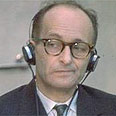
Papers: CIA concealed Eichmann whereabouts
Documents released by National Archives reveal US intelligence agency kept quiet about Nazi war criminal's location, for fear he might expose anticommunist efforts in West Germany
Determined to win the Cold War, the CIA kept quiet about the whereabouts of Nazi war criminal Adolf Eichmann in the 1950s for fear he might expose undercover anticommunist efforts in West Germany, according to documents released Tuesday.
The 27,000 pages released by the National Archives are among the largest post-World War II declassifications by the CIA. They offer a window into the shadowy world of US intelligence — and the efforts to use former Nazi war criminals as spies, sometimes to detrimental effect.
The war criminals "peddled hearsay and gossip, whether to escape retribution for past crimes, or for mercenary gain, or for political agendas not necessarily compatible with American national interests," Robert Wolfe, an expert on German history and former archivist at the National Archives, said at a news briefing announcing the document release.
CIA pressured journalists
In a March 19, 1958, memo to the CIA, West German intelligence officials wrote that they knew where Eichmann was hiding. Eichmann played a key role in transporting Jews to death camps during World War II. "He is reported to have lived in Argentina under the alias 'Clemens' since 1952," authorities wrote.
But neither side acted on that information because they worried what he might say about Hans Globke, a highly placed former Nazi and a chief adviser in West Germany helping the US coordinate anticommunist initiatives in that country.
Two years later, when Jewish authorities captured Eichmann, the CIA pressured journalists to delete references to Globke.
"Entire material has been read. One obscure mention of Globke which Life omitting at our request," CIA Director Allen Dulles wrote in a Sept. 20, 1960, internal memorandum, after Life magazine purchased Eichmann's memoir.
Among the other findings:
- Former Nazi officers such as Heinz Felfe, who served in the "Gehlen organization" — the West German intelligence service which in its early years was sponsored by the US Army and then the CIA — were typically hired by the Soviet Union to be double agents.
- The CIA routinely misled U.S. immigration officials in the mid-1970s about the role of CIA agent Tscherim Soobzokov and his connection to Nazi war crimes.
The documents were among the latest released under a 1999 law — resisted by the CIA — that called for disclosure of government records related to war crimes committed by the Nazi and Japanese governments.
"CIA has been struggling with the nettlesome problem of how to balance the public's interest in the historical record of CIA's connections to Nazis, and an intelligence agency's need ... to protect the identities of sources," said Stanley Moskowitz, a former CIA official who is now a consultant to the agency.
"The passage of time has shifted the balance," he said.
Material relating to Japanese war crimes were scheduled to be released later this summer.
The Simon Wiesenthal Center
The Simon Wiesenthal Center released a statement saying that the story constitutes “a black mark on American history.”
Rabbi Abraham Cooper, associate dean of the Wiesenthal Center: "In the decades following the Second World War, Wiesenthal was virtually alone in trying to bring Nazi war criminals to the Bar of Justice. Today’s revelations confirm what he was really up against in the pursuit of justice for the victims of history’s worst genocide."










